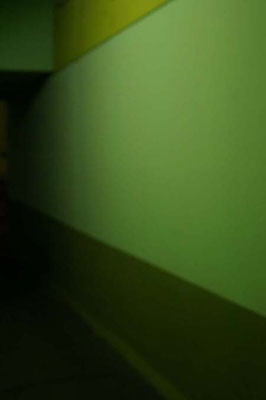
EINGANG
140x93cm
2006
© VG Bild-Kunst Bonn
Stefan Heyne »
Blind Spot
Exhibition: 30 May – 11 Jul 2009
Kaune, Sudendorf
Albertusstr. 26 / Zeughausstr. 13
50667 Köln
Kaune Contemporary
Gereonskloster 12 (Kapelle)
50670 Köln
+49 (0)221-278 578 14
info@gallery-kps.com
www.kaunegallery.com
Tue, Wed 10-15; Thu,Fri 10-18; Sat 12-17
The Berlin-based artist Stefan Heyne (born in 1965) works in a constant exploration of the boundaries between painting and photography. His photographs are never descriptive and don't seek to depict visible reality. Instead, his motives attain autonomy by renouncing the notion of reproduction – a quality long considered to be central to the medium. Heyne's works are characterised by a vigilant manipulation of the obscured detailing of the objects and spaces shown. The allure of his prints lies in the magical spectrum of their colours, their velvety surfaces and their quality as objects. Consistent reduction leads to a fascinating amalgam of the familiar and mysterious. Evoking visual memories as well as smells or sounds, the works pose questions regarding the potential of photography, how photography and painting can benefit from dialogue and how visual qualities relate to the psychology of perception. However, Heyne is far from being pictorialist, an approach adopted in order to emphasise the autonomy of the photographic medium. His images release themselves from their subject matter and allow cognition itself to become a theme: "Stefan Heyne's works seem to force the eye to watch itself in the process of seeing." (Christoph Tannert) Heyne's imaginary spaces are concisely constructed and lure viewers into stepping up more closely. In their accentuated simplicity and tranquillity they demand a high degree of participation. In an attempt to fathom the unfathomable, viewers find themselves looking into a field of projection for their own conceptions.
Der Berliner Künstler Stefan Heyne (Jg. 1965) arbeitet konsequent an der Schnittstelle zwischen Malerei und Fotografie. Seine Fotografien sind nie deskriptiv, es geht nicht darum, das Sichtbare wiederzugeben. Dieser Widerstand gegen die Abbildqualität der Fotografie, die lange als zentrale Eigenschaft des Mediums galt, resultiert in einer Autonomie der fotografierten Motive. Die Anziehungskraft von Heynes Arbeiten, geprägt von einer umsichtigen Manipulation der durch Unschärfe verrätselten Gegenstände und Räume, verdankt sich der Farbmagie der Abzüge, der samtenen Oberfläche der Bilder und ihrem Objektcharakter. Durch konsequente Reduktion entsteht eine faszinierende Mischung von Vertrautem und Rätselhaften; Erinnerungen an Gesehenes blitzen auf wie Gerüche oder Klänge, stellen Fragen danach, was Fotografie vermag, wie befruchtend der Dialog zwischen Malerei und Fotografie sein kann und wie das Verhältnis von Optik und Wahrnehmungspsychologie ist. Von einer piktorialistischen Attitüde, der sich das fotografische Medium immer wieder bediente, um seinen Autonomiestatus zu betonen, ist Heyne allerdings weit entfernt. Die Unabhängigkeit seiner Bilder von den dargestellten Dingen lässt das Erkennen selbst zum Thema seiner Arbeiten werden: "Bei Stefan Heyne kommt es mir vor, als werde das Auge dazu genötigt, sich selbst beim Sehen zuzusehen." (Christoph Tannert) Heynes imaginäre Räume sind konzise kalkuliert und verführen ihre Betrachter zum intensiven Blick. In ihrer betonten Reduktion und Stille fordern die Fotografien in besonderem Maße die Partizipation des Betrachters, der das Unergründliche zu durchdringen sucht und bemerkt, wie es zum Projektionsfeld eigener Vorstellungen wird.